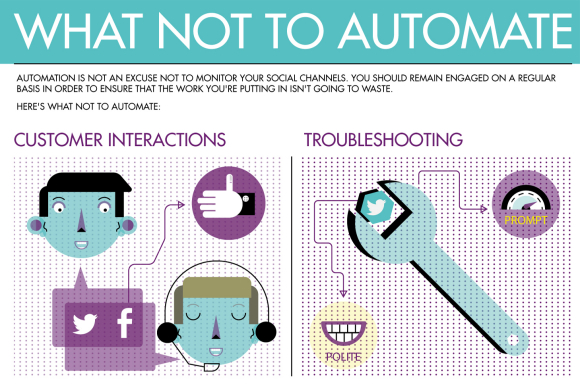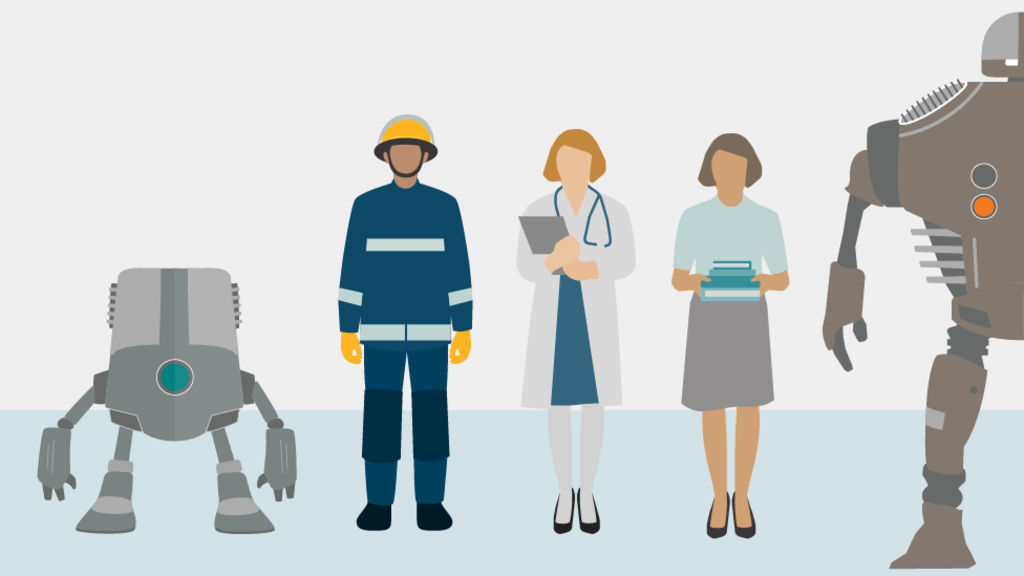
How to Incorporate Automation Without Replacing Jobs
Will your job be replaced by robots?
Most likely the answer is no, but with all the advances in technology over the last several decades, some experts believe that humanity is setting itself up for technological unemployment, or the loss of jobs caused by technology.
This is certainly a reality for many people, especially in fields requiring more automation for productivity, like manufacturing. But what about digital jobs like social media marketing, software development, or even sales?
Can these roles be entirely replaced with automated solutions? Or, perhaps more importantly, should they be?
While automation can certainly improve digital productivity, the reality is that these virtual jobs still require the human touch. That doesn’t mean you can’t utilize automation to make things easier, however.
Here’s what you need to know about incorporating automation into your team’s roles without replacing people all together.
[content_upgrade cu_id=”371″]Don’t miss these 9 Automation Tools Your Current Team Can Use[content_upgrade_button]Click Here[/content_upgrade_button][/content_upgrade]

 Source: Online Social Media
Quality Assurance
They say that to err is human, which should mean that non-human programs should be error free, right? Unfortunately, that’s not always the case. There are many areas where mistakes can be made by automated programs and if left unnoticed, could wreak havoc on your operations.
This is particular true if the automation will interact with human users. Customer service is still important – your program could be perfect but your customers are not. Automation can help the process (chatbots, for example), but it won’t win you brownie points with customers who have complex questions.
Machines break, programs fail, and data can be analyzed or applied incorrectly. Automation can certainly minimize errors in most cases, but it’s not foolproof. There will always need to be a human eye watching for errors or for ways to improve systems that a program won’t spot on its own.
Programming and Software Development
There are rumors of a programmer who automated every aspect of his job for 6 years before his boss found out (and fired him). Whether it’s true or not, it does make you think about the nature of programming.
It can certainly be time consuming to manage a team of developers to run and build your software, and there are many aspects of that role that can be automated to save time, but the trouble with complete automation comes down to creativity and problem solving.
Even the best automated program will never be able to develop custom solutions for your business and solve problems for you on-the-fly, both of which are required for success.
While automation can help programmers and dev teams save time, reduce errors, and manage workloads, it can’t replace the human intuition needed to produce quality software or to troubleshoot creatively when need be.
Source: Online Social Media
Quality Assurance
They say that to err is human, which should mean that non-human programs should be error free, right? Unfortunately, that’s not always the case. There are many areas where mistakes can be made by automated programs and if left unnoticed, could wreak havoc on your operations.
This is particular true if the automation will interact with human users. Customer service is still important – your program could be perfect but your customers are not. Automation can help the process (chatbots, for example), but it won’t win you brownie points with customers who have complex questions.
Machines break, programs fail, and data can be analyzed or applied incorrectly. Automation can certainly minimize errors in most cases, but it’s not foolproof. There will always need to be a human eye watching for errors or for ways to improve systems that a program won’t spot on its own.
Programming and Software Development
There are rumors of a programmer who automated every aspect of his job for 6 years before his boss found out (and fired him). Whether it’s true or not, it does make you think about the nature of programming.
It can certainly be time consuming to manage a team of developers to run and build your software, and there are many aspects of that role that can be automated to save time, but the trouble with complete automation comes down to creativity and problem solving.
Even the best automated program will never be able to develop custom solutions for your business and solve problems for you on-the-fly, both of which are required for success.
While automation can help programmers and dev teams save time, reduce errors, and manage workloads, it can’t replace the human intuition needed to produce quality software or to troubleshoot creatively when need be.


Roles That Should Never Be Fully Automated
One of the benefits of technology is saving time. There are now hundreds of online tools available that can take manual tasks and perform them rapidly with little oversight, and that’s part of the beauty of automation – it does the heavy lifting and you get to simply be creative. But technology certainly isn’t perfect, and there are many times when it just can’t replace the human brain. Here are a few roles where that might be the case: Content and Social Media Marketing Believe it or not, there is non-human automation that exists for developing content. Automated Insights, for example, is an application that produces content sans humanity (dubbed “robot journalism”) and it does create shareable blog and social media content somewhat effectively. But while this type of automation is serviceable in generating basic reports and short, fact-driven news stories, it’s still missing one essential component to be fully successful: connection. The rise in technology has also led to a certain level of relational disconnect, and marketers are now realizing that they need to infuse creativity and personality into their marketing strategies to connect to and win over customers. Automated software can certainly send out a Tweet on time, but it can’t respond to customers in a way that fosters that connection, and therefore can never produce the same results as a human being. Source: Online Social Media
Quality Assurance
They say that to err is human, which should mean that non-human programs should be error free, right? Unfortunately, that’s not always the case. There are many areas where mistakes can be made by automated programs and if left unnoticed, could wreak havoc on your operations.
This is particular true if the automation will interact with human users. Customer service is still important – your program could be perfect but your customers are not. Automation can help the process (chatbots, for example), but it won’t win you brownie points with customers who have complex questions.
Machines break, programs fail, and data can be analyzed or applied incorrectly. Automation can certainly minimize errors in most cases, but it’s not foolproof. There will always need to be a human eye watching for errors or for ways to improve systems that a program won’t spot on its own.
Programming and Software Development
There are rumors of a programmer who automated every aspect of his job for 6 years before his boss found out (and fired him). Whether it’s true or not, it does make you think about the nature of programming.
It can certainly be time consuming to manage a team of developers to run and build your software, and there are many aspects of that role that can be automated to save time, but the trouble with complete automation comes down to creativity and problem solving.
Even the best automated program will never be able to develop custom solutions for your business and solve problems for you on-the-fly, both of which are required for success.
While automation can help programmers and dev teams save time, reduce errors, and manage workloads, it can’t replace the human intuition needed to produce quality software or to troubleshoot creatively when need be.
Source: Online Social Media
Quality Assurance
They say that to err is human, which should mean that non-human programs should be error free, right? Unfortunately, that’s not always the case. There are many areas where mistakes can be made by automated programs and if left unnoticed, could wreak havoc on your operations.
This is particular true if the automation will interact with human users. Customer service is still important – your program could be perfect but your customers are not. Automation can help the process (chatbots, for example), but it won’t win you brownie points with customers who have complex questions.
Machines break, programs fail, and data can be analyzed or applied incorrectly. Automation can certainly minimize errors in most cases, but it’s not foolproof. There will always need to be a human eye watching for errors or for ways to improve systems that a program won’t spot on its own.
Programming and Software Development
There are rumors of a programmer who automated every aspect of his job for 6 years before his boss found out (and fired him). Whether it’s true or not, it does make you think about the nature of programming.
It can certainly be time consuming to manage a team of developers to run and build your software, and there are many aspects of that role that can be automated to save time, but the trouble with complete automation comes down to creativity and problem solving.
Even the best automated program will never be able to develop custom solutions for your business and solve problems for you on-the-fly, both of which are required for success.
While automation can help programmers and dev teams save time, reduce errors, and manage workloads, it can’t replace the human intuition needed to produce quality software or to troubleshoot creatively when need be.

How to Add Automation to Human Roles
Of course, that doesn’t mean every role in your business needs to have a human attached to it, at least not in a dedicated role. Automation can improve upon the human touch to improve productivity and responsiveness. Here’s what to look for:- Automate the easiest processes first
- Focus on one process at a time
- Choose an automation tool that fits your current needs

